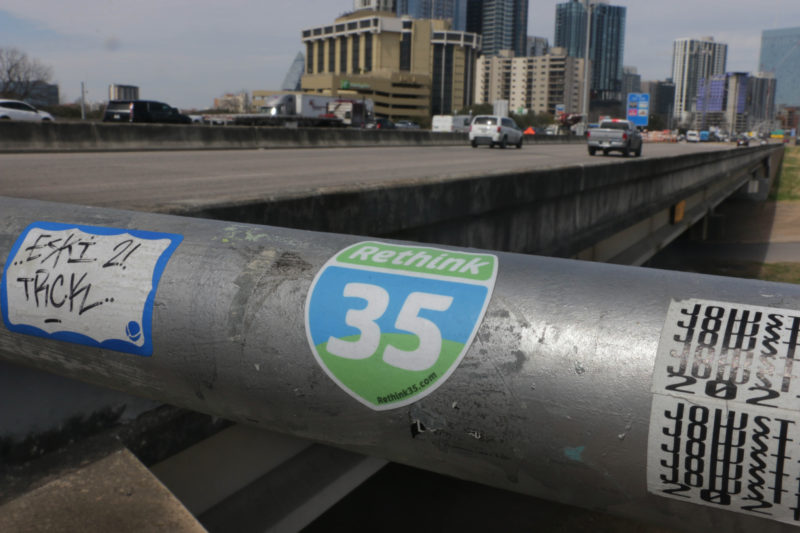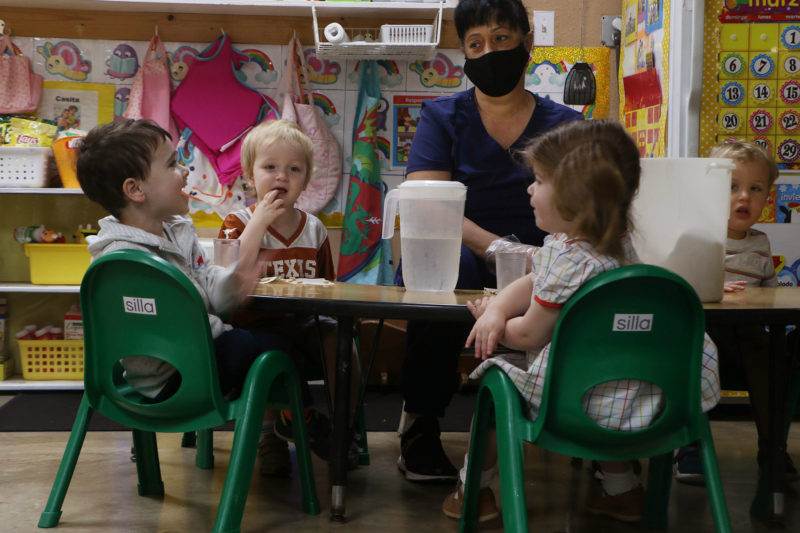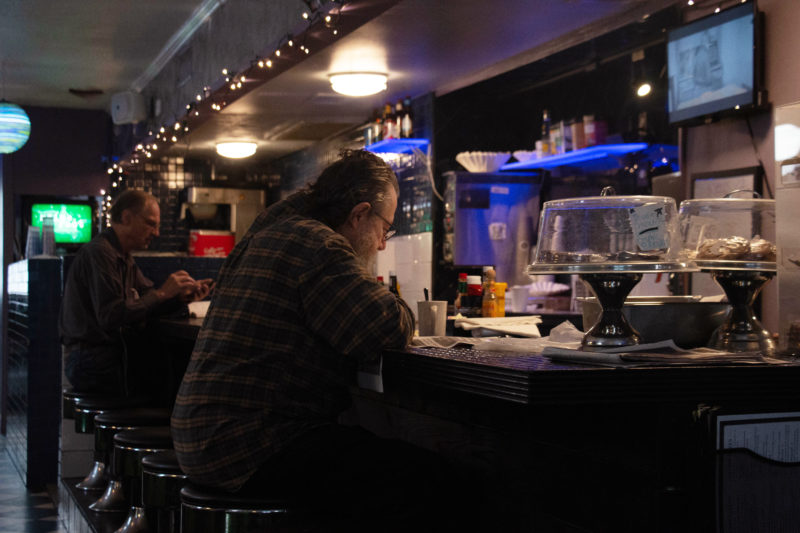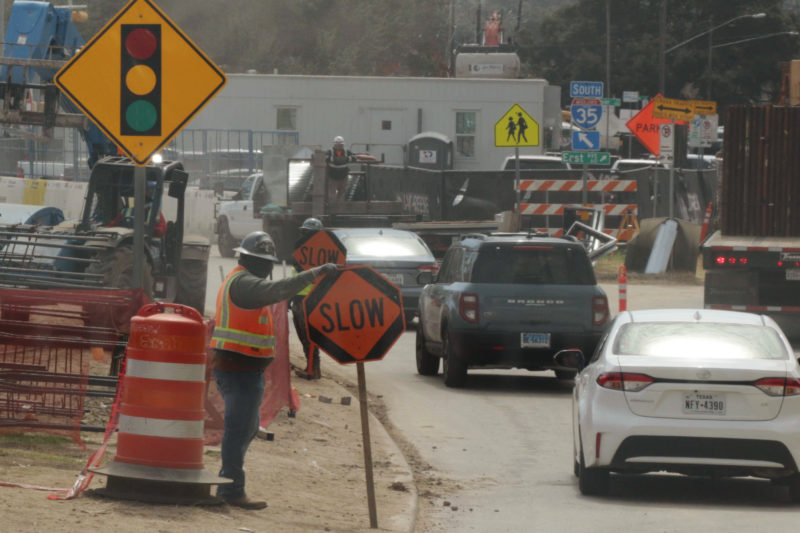Residents, Businesses Face Prospect of Moving to Make Way for I-35 Expansion
By Zacharia E. Washington
Reporting Texas

Traffic on I-35 moves toward downtown Austin, Texas, as the highway prepares for an expansion project that state officials hope will alleviate congestion. Celeste Ramirez/Reporting Texas
Established in January 2000, the Escuelita Del Alma child care center was forced to move from Congress Avenue in 2006 when the property was sold for construction of what is now the JW Marriott Austin hotel.
Escuelita Del Alma founder Dina Flores immediately started looking for another location for the day care center, settling into a spot at Interstate 35 and 31st Street in December 2008.

Teacher Maria I. Coto cares for students who attend Escuelita Del Alma in Austin, Texas, March 30, 2022. The expansion of Interstate Highway 35 may force children to relocate to a different location. Celeste Ramirez/Reporting Texas
Now, 14 years later, Flores’ day care center is facing another potential relocation — this time due to the Texas Department of Transportation’s plan to expand and reshape I-35 through the heart of Austin.
TxDOT’s $4.9 billion I-35 Capital Express Central project is intended to reduce congestion and improve the safety of the highway. The Austin section of I-35 has twice been named in the Congress for the New Urbanism’s “Freeways Without Futures” report as one of the American highways in most need of elimination. That section of highway ranked second among Texas’ most congested roadways by Texas A&M’s Transportation Institute.
TxDOT is proposing to tear down I-35’s upper decks that head north from the University of Texas campus, lower the interstate’s lanes and add two non-tolled high-occupancy vehicle lanes in both directions. The project spans all of downtown Austin — from U.S. 290 East on the north to Texas 71/Ben White Boulevard on the south.

Hal, 74, who prefers to use his first name only, reads the paper at Stars Cafe in Austin, Texas, on March 7, 2022. He has sat in the same seat, every morning, for the past 35 years. Before the pandemic, he described the cafe as his “home away from home.”
Although the final design of the project remains to be set, Escuelita Del Alma, Stars Cafe, a few other long-running businesses, neighborhoods and other residential areas along I-35 are in jeopardy of being displaced or severely impacted.
“Another location? I don’t know that we’ll be able to find something that’s close to where we’re at right now,” Flores said.
Advocacy groups Rethink35 and Reconnect Austin have been fighting TxDOT’s highway expansion. Although Rethink35 and Reconnect Austin have different motives, they both have one end goal: to stop the highway expansion.
“We owe it to ourselves and to our children,” Rethink35 co-founder Adam Greenfield said. “They’re depending on us to stop this expansion and put something better in place.”

Construction slows traffic along an I-35 frontage road in Austin, Texas, on March 2, 2022. Texas Department of Transportation wants to revamp the interstate to alleviate congestion such as this. Celeste Ramirez/Reporting Texas
Rethink35 wants TxDOT to divert non-local highway traffic around Austin and replace I-35 with an urban boulevard. Reconnect Austin also wants a boulevard but is calling for the interstate to be buried underneath the boulevard, not completely removed.
“I think we both agree that Austin needs a better corridor. We need something really different for I-35,” Reconnect Austin’s Addie Walker said. “Both of our primary goals are to improve this part of the city to the benefit of Austinites.”
History of I-35
Construction on Interstate 35 in Austin began in the 1950s. The highway first opened to traffic in 1962. In the 1970s, the upper decks were built, which were the last major upgrades on the downtown section of highway, according to TxDOT.
I-35 effectively replaced East Avenue, which ran along downtown Austin’s eastern edge. East Avenue was considered a gathering place for communities of color, and the construction of the highway changed that, displacing those communities. Interstate 35 then became a socioeconomic barrier dividing white, affluent communities to the west of the highway and minority, lower-income communities to the east.
“(The construction of I-35) did affect communities of color more,” said Austin American Statesman columnist and local historian Michael Barnes.
Barnes said the interstate also makes it difficult for businesses adjacent to them to flourish.
“The freeways inevitably not only break up neighborhoods and divide neighborhoods, but they kind of captivate the businesses that are along them,” he said. “Because no one is going to invest long term into a property that is going to be taken over by the highway department.”
Communities and advocacy organizations have argued that the planned expansion could make the socioeconomic scar of I-35 in Austin only worse.
“I think continuing to displace minority-owned businesses and homes and even potentially affordable housing units on the east side of the highway is sort of doubling down on that really nasty history,” Walker said. “I don’t think that’s something that we want to be repeating.”
Community response
More than 140 properties, businesses and housing included, are in jeopardy of being displaced by the Capital Express Central project.
“We understand that right-of-way acquisition and potential displacements are a real and valid concern for our stakeholders and property owners along I-35,” TxDOT told Reporting Texas in a statement. “(We’re) meeting weekly with property owners along the corridor to better understand their needs and discuss the project.”
Flores said she has not heard from TxDOT. She heard about the potential displacement through advocacy groups, her landlords and families of nearby neighborhoods that attend the day care center.

Children play at Escuelita del Alma which may be forced to move if the I-35 expansion takes place. Celeste Ramirez/Reporting Texas
Escuelita Del Alma serves many families from the Cherrywood neighborhood who also may be impacted by the Capital Express Central project.
Cherrywood, which was developed in the 1940s and ‘50s, lies just east of I-35 between Manor Road and Airport Boulevard — a key section that TxDOT plans to remake. The neighborhood association has been actively following the process and attending TxDOT’s community feedback meetings, but residents say they are still not feeling like the highest priority in the project.
“(TxDOT) is not prioritizing the people who actually live near, or frankly under the highway, and pay taxes in the city, and deserve to have the air pollution, the noise pollution and the segregation mitigated, if not completely eliminated, in this project,” Cherrywood Neighborhood Association vice chair Brandy Savarese said.
Residents are worried about the noise, pollution and danger the highway expansion could bring.

Cars merge onto I-35 in downtown Austin, Texas, where proposed changes to the interstate could affect its frontage roads. Celeste Ramirez/Reporting Texas
Some community recommendations include making the I-35 frontage road into a boulevard or capping and stitching the highway in the residential areas. A cap is a large deck over a lowered section of a highway, essentially burying the highway and a stitch is a widened bridge on either side of a cross street over a lowered highway, creating more space for pedestrians to cross over the highway.
Other communities being impacted by the Capital Express Central project include Blackland Neighborhood and Aria Grand Apartments, who have affordable housing, according to community leaders.
“(TxDOT is) not listening to us. They’re not looking at this with a creative eye,” Cherrywood resident Matt Rutledge said.
The fight continues
Rethink35’s main approach to stopping expansion is “community power,” Greenfield said.
“If we had every resident of Austin and the Central Texas region against expansion and for Rethink35, we would win,” he said.
The group is hoping to gain support from the public and push the Austin City Council to stand against the project.
In Houston, the advocacy group Stop TxDOT I-45 fought against the North Houston Highway Improvement Project, a highway expansion stretching from downtown to Beltway 8. This highway expansion project put more than 1,000 locations at risk for displacement, most being Black and brown residences, schools and businesses.
Harris County sued TxDOT in 2021, claiming civil rights violations, and the Federal Highway Administration paused the I-45 highway expansion project in Houston to investigate its impact on the community.
Barnes says there also needs to be an appeal to the federal level about the Capital Express Central project.
“Without federal money, the project won’t get done,” he said. “(TxDOT) just wants traffic to move more freely, the problem is they don’t think it through. I think it’s incumbent on the rest of the community to make them think it through.”
TxDOT is currently in the environmental study and schematic design phase of the I-35 project. In January, after the feedback period from the community, TxDOT released Modified Alternative 3 — which proposes the possibility of caps and pairing the frontage roads on one side of the highway, creating a two-way boulevard, rather than having the frontage roads split by the highway.
TxDOT says that Modified Alternative 3 of the Capital Express Central project is expected to reduce the footprint of the project, possibly lowering the frequency of displacement, but the community is not satisfied.
“This is a once-in-a-generation opportunity to fix what is a horrific bi-section of the city of Austin,” Savarese said. “TxDOT and the city of Austin’s plans fall far short of doing that for the people who are impacted by the project.”
Construction on the I-35 Capital Express Central project is anticipated to begin in late 2025. Until then, some in the Austin community continue to fight.